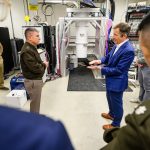Our research in chiplet-based architectures and heterogeneous integration is reshaping how microelectronics are built—making them more flexible, efficient, and scalable for data-heavy applications like AI and machine learning.
Rather than relying on one big chip to do everything, we’re designing systems of smaller, specialized chiplets that work together—like assembling a team where each member has a specific role. But making that team function seamlessly takes serious engineering: managing heat, distributing power efficiently, and ensuring flawless communication between components.
And this isn’t just theory. We have already built energy-saving chiplet prototypes like the Mamba chiplet, showing measurable performance gains. Our students are learning these skills hands-on, and local companies are applying this research to accelerate product development and stay competitive.

Latest News

Kawasaki named a Moore Foundation Experimental Physics Investigator
Jason Kawasaki, an associate professor in materials science and engineering at the University of Wisconsin-Madison, has been named a 2025 Gordon and Betty Moore Foundation Experimental Physics Investigator. Selection to the program is a prestigious honor …

2025 Nobel Prize Laureate John Martinis’s Connections to UW–Madison
Wisconsin CHIPS congratulates the 2025 laureates of The Nobel Prize in Physics—John Clarke, Michel H. Devoret, and John M. Martinis—for observation of quantum-mechanical tunneling in an electrical circuit based on superconductors! Excitingly, Martinis has connections to UW–Madison through shared research and his co-founded company Qolab.

UW fostering closer research ties with federal defense, cybersecurity agencies
UW–Madison is building stronger research partnerships with federal defense and cybersecurity agencies to advance technologies that serve the public good. A recent campus visit from Department of Defense and NSA leaders highlighted shared priorities in AI, quantum computing, and secure systems.
- More News











